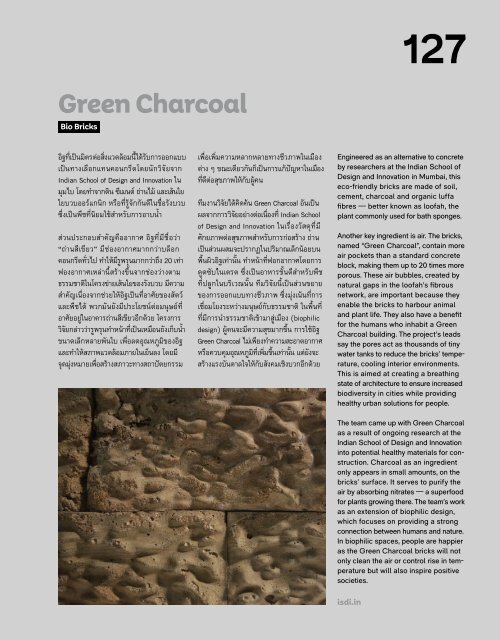ASA Journal 16/2023
Create successful ePaper yourself
Turn your PDF publications into a flip-book with our unique Google optimized e-Paper software.
127<br />
Green Charcoal<br />
Bio Bricks<br />
อิฐที่เป็นมิตรต่อสิ่งแวดล้อมนี้ได้รับการออกแบบ<br />
เป็นทางเลือกแทนคอนกรีตโดยนักวิจัยจาก<br />
Indian School of Design and Innovation ใน<br />
มุมไบ โดยทำาจากดิน ซีเมนต์ ถ่านไม้ และเส้นใย<br />
ใยบวบออร์แกนิก หรือที่รู้จักกันดีในชื่อรังบวบ<br />
ซึ่งเป็นพืชที่นิยมใช้สำาหรับการอาบน้ำา<br />
ส่วนประกอบสำาคัญคืออากาศ อิฐที่มีชื่อว่า<br />
“ถ่านสีเขียว” มีช่องอากาศมากกว่าบล็อก<br />
คอนกรีตทั่วไป ทำาให้มีรูพรุนมากกว่าถึง 20 เท่า<br />
ฟองอากาศเหล่านี้สร้างขึ้นจากช่องว่างตาม<br />
ธรรมชาติในโครงข่ายเส้นใยของรังบวบ มีความ<br />
สำาคัญเนื่องจากช่วยให้อิฐเป็นที่อาศัยของสัตว์<br />
และพืชได้ พวกมันยังมีประโยชน์ต่อมนุษย์ที่<br />
อาศัยอยู่ในอาคารถ่านสีเขียวอีกด้วย โครงการ<br />
วิจัยกล่าวว่ารูพรุนทำาหน้าที่เป็นเหมือนถังเก็บน้ำ า<br />
ขนาดเล็กหลายพันใบ เพื่อลดอุณหภูมิของอิฐ<br />
และทำาให้สภาพแวดล้อมภายในเย็นลง โดยมี<br />
จุดมุ่งหมายเพื่อสร้างสภาวะทางสถาปัตยกรรม<br />
เพื่อเพิ่มความหลากหลายทางชีวภาพในเมือง<br />
ต่าง ๆ ขณะเดียวกันก็เป็นการแก้ปัญหาในเมือง<br />
ที่ดีต่อสุขภาพให้กับผู้คน<br />
ทีมงานวิจัยได้คิดค้น Green Charcoal อันเป็น<br />
ผลจากการวิจัยอย่างต่อเนื่องที่ Indian School<br />
of Design and Innovation ในเรื่องวัสดุที่มี<br />
ศักยภาพต่อสุขภาพสำาหรับการก่อสร้าง ถ่าน<br />
เป็นส่วนผสมจะปรากฏในปริมาณเล็กน้อยบน<br />
พื้นผิวอิฐเท่านั้น ทำาหน้าที่ฟอกอากาศโดยการ<br />
ดูดซับไนเตรต ซึ่งเป็นอาหารชั้นดีสำาหรับพืช<br />
ที่ปลูกในบริเวณนั้น ทีมวิจัยนี้เป็นส่วนขยาย<br />
ของการออกแบบทางชีวภาพ ซึ่งมุ่งเน้นที่การ<br />
เชื่อมโยงระหว่างมนุษย์กับธรรมชาติ ในพื้นที่<br />
ที่มีการนำาธรรมชาติเข้ามาสู่เมือง (biophilic<br />
design) ผู้คนจะมีความสุขมากขึ้น การใช้อิฐ<br />
Green Charcoal ไม่เพียงทำาความสะอาดอากาศ<br />
หรือควบคุมอุณหภูมิที่เพิ่มขึ้นเท่านั้น แต่ยังจะ<br />
สร้างแรงบันดาลใจให้กับสังคมเชิงบวกอีกด้วย<br />
Engineered as an alternative to concrete<br />
by researchers at the Indian School of<br />
Design and Innovation in Mumbai, this<br />
eco-friendly bricks are made of soil,<br />
cement, charcoal and organic luffa<br />
fibres — better known as loofah, the<br />
plant commonly used for bath sponges.<br />
Another key ingredient is air. The bricks,<br />
named “Green Charcoal”, contain more<br />
air pockets than a standard concrete<br />
block, making them up to 20 times more<br />
porous. These air bubbles, created by<br />
natural gaps in the loofah’s fibrous<br />
network, are important because they<br />
enable the bricks to harbour animal<br />
and plant life. They also have a benefit<br />
for the humans who inhabit a Green<br />
Charcoal building. The project’s leads<br />
say the pores act as thousands of tiny<br />
water tanks to reduce the bricks’ temperature,<br />
cooling interior environments.<br />
This is aimed at creating a breathing<br />
state of architecture to ensure increased<br />
biodiversity in cities while providing<br />
healthy urban solutions for people.<br />
The team came up with Green Charcoal<br />
as a result of ongoing research at the<br />
Indian School of Design and Innovation<br />
into potential healthy materials for construction.<br />
Charcoal as an ingredient<br />
only appears in small amounts, on the<br />
bricks’ surface. It serves to purify the<br />
air by absorbing nitrates — a superfood<br />
for plants growing there. The team’s work<br />
as an extension of biophilic design,<br />
which focuses on providing a strong<br />
connection between humans and nature.<br />
In biophilic spaces, people are happier<br />
as the Green Charcoal bricks will not<br />
only clean the air or control rise in temperature<br />
but will also inspire positive<br />
societies.<br />
isdi.in

















